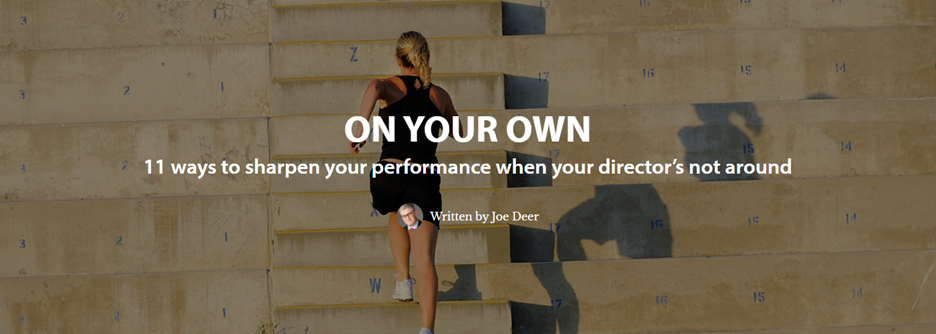
Click to Teach/Click to Learn: Preparing a Role
In "Preparing a Role" you will begin to work on developing a believable monologue performance, using character analysis, experimentation and reflection. This lesson is based on a unit created by theatre educator Jordan Herkowitz and Broadway performer and teaching artist Arbender Robinson. In this lesson, you can hear feedback on student performances from Mr. Robinson, who has coached hundreds of students for Broadway and college auditions.
Step 1: Get Inspired
In this award winning performance Anjali Raghaven demonstrates her skill in preparing a performance and developing a character.
Anjali Raghaven - Superior Thespy Performance
This video is an example of a polished performance adjudicated in a national competition.
Monologue from The Curious Case of the Watson Intelligence by Madeleine George shared for educational purposes by special permission from the Gersh Agency. Monologue from Wedding Belles by Alan Bailey and Ronnie Claire Edwards shared for educational purposes by special permission from the author Alan Bailey.
A Thespy Adjudicator Offers Tips
Formerly known as the National Individual Events, EdTA's International Thespian Excellence Awards honor student excellence in theatre.
Student performances are adjudicated using an assessment rubric and assigned one of four possible ratings; Superior, Excellent, Good or Fair. In this video Acting Adjudicator Jo Lane talks about what makes a Superior performance.
Step 2: Choose a Monologue
Your first job is to choose the script or text you will be working on as you learn to develop a role. Choose something from a published play, and make sure you understand and like the character. If you plan on recording and sharing your monologue online, choose a play which does not require copyright permissions, such as a selection from Shakespeare or other historic piece. This list of plays from Portland State University makes a good starting point, or check out these four royalty free modern day plays written for EdTA by playwright Jon Jory and free for educational use.
Step 3: Understand your Character
Actors begin preparing their role by reading the entire script and then analyzing the character to deeply understand what makes them tick. To analyze your character, study the role to determine the given circumstances (what the script says about the character and the events of the story) and use your imagination to fill in a back story that would be logical for this person in this time and place. Answer these questions about your character: (You may download this form here.)
Who is your character?
• Name, nickname, alias
• Age, date and place of birth
• Relatives, key relationships, enemies
• Likes, dislikes, favorites, hobbies
• Fears
• Skills, education, career
• Opinions, morality, ethics, beliefs,
religion
• Origins
• Sociological influences
• Appearance/physical traits:
height, weight, measurements, hair
color, hair length, hairstyle, eye color,
jewelry, tattoos/marks, etc.
• Words, language, style of speech
2 What time is it?
• Century
• Season
• Year, Day, Minute, Significance of
Time
3 Where is your character?
• Country
• City
• Neighborhood
• Home
• Room
• Area of room
4 What surrounds your
character?
• Animate and inanimate objects-complete
details of environment
5 What are your character’s
given circumstances?
• Past, present, future of all of the events
6 What are your character’s
relationships?
• Relation to total events, other characters,
and to things
7 What does your character
want?
• Character's wants and needs
• Character's motivations
• The immediate and main objective
8 What is in your
character’s way?
• Obstacles which prevent character from
getting his/her wants and needs
9 What does your character
have to do to get what
he/she wants?
• The action(s): physical and verbal, also
Step 4: Experiment with Choices
After you have memorized your monologue, you are ready to start experimenting by trying out different ways of creating the character's voice, movements and physicality. The early stages of preparing your role may look very different from the final stages when you have achieved a polished stage ready performance. View the video below of a monologue performance, which when combined with the remarks and observations of artist Arbender Robinson will help you understand the actor's craft of continually developing and refining a character.
What did Mr. Robinson say about this performance? What were his suggestions for growth? How does this help you understand the actor's craft? and suggestions for growth.
How can you apply this advice to your acting?
Viola from Shakespeare's Twelfth Night.
A prepared monologue well along in the process.
Broadway performer and coach and EdTA Teaching Artist Arbender Robinson, comments on the performance, offering suggestions for refinement and growth.
Diving Deeper
Want to keep refining your monologue performance? Click the image below to read a dramatics.org article that gives you 11 ways to keep sharpening your theatre performance on your own.

Classroom Connections
High School Proficient Standards
TH:Cr1.1.l.c
Use script analysis to generate ideas about a character that is believable and authentic in a drama/theatre work.
TH:Pr6.1.la
Perform a scripted drama/theatre work for a specific audience.
TH:Pr5.1.la
Practice various acting techniques to expand skills in a rehearsal or drama/theatre performance.
TH:Re9.1.lc
Formulate a deeper understanding and appreciation of a drama/theatre work by considering its specific purpose or intended audience.
| Access Date | Quiz Result | Score | Actions |
|---|
Learning Center
- Webinars
- Adjudication Trainings
- Featured Courses
- Full Course List
- Lesson Plan Library
- Click to Teach Interactive Online Lessons
- Resources for New Theatre Teachers
- Technical Theatre Educator's Manual
- Connected Arts Networks
- Diverse Resources for Theatre Education
- Behind the Scenes Technical Theatre Curriculum
- Social & Emotional Learning
- Additional Standards Based Instructional Resources
- Search the Catalog
- Cart (0 items)
Full Site Search
Membership Benefits
Join EdTA for full access to our professional development and standards-based teaching resources, including:
- 300+ lesson plans
- Click to Teach online lessons
- K-12 curriculum
- Webinars
- And more!




